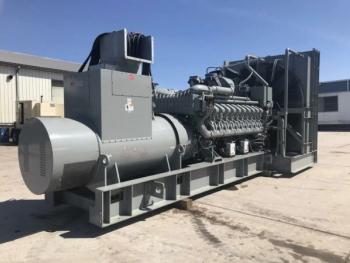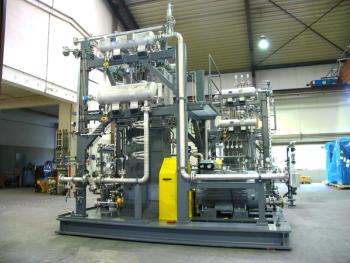
- Handbook 2026
- Volume 66
- Issue 6
U.S. Power Industry Outlook 2026
Key Takeaways
- Renewables dominate new power generation plans, but their share has decreased slightly, with natural gas-fired generation making a comeback.
- No new coal-fired generators are planned, despite a favorable stance from the Trump administration, while nuclear power, especially SMRs, is gaining interest.
Roiled by executive orders, agency rulemakings, and other initiatives, the U.S. power generation landscape has shifted dramatically this year from renewables to dispatchable generation. What’s more, vast and ever-rising estimates of electric demand growth created by data centers, artificial intelligence, and advanced manufacturing are adding to the turbulence.
President Donald Trump spent a good bit of the first year of his second term fulfilling his campaign promises to pursue an “energy dominance” agenda. For electricity, dispatchable generation, including gas, nuclear, and coal, was in, and renewable energy, such as solar and wind, was out. Particularly favored were efforts to boost the extraction and use of fossil fuels while limiting federal support for renewable electric generation.
The flurry of executive orders and the dizzying back-and-forth on tariffs played havoc with planners in the electricity business. As utilities upped their capital spending plans to build out their transmission and distribution (T&D) networks and build new generation to meet the demands of data centers, advanced manufacturing, and AI, the president levied significant tariffs on vital materials for the power industry, including copper products, steel, and aluminum. All this while the world sweltered through yet another year of record temperatures, just as it did in 2024 and 2023.
Each year, Industrial Info Resources (IIR), a Sugar Land, Texas-based industrial market intelligence firm, analyzes the rolling five-year plans developers have made to build new electric generation in the U.S. This year, there are several striking departures from prior five-year assessments. Specifically:
- Renewables still constitute the largest sector of power generation scheduled to begin construction over the 2026-2030 period, with 812 GW planned to begin construction over that period, up from 796 GW for the 2025-2029 period. On a percentage basis, about 85% of planned construction kickoffs over the next five years will be renewables, down from 91% for the previous five-year period.
- Natural gas-fired power generation is making a comeback, with about 107 GW of new-build capacity scheduled to begin construction over the 2026-2030 period. That’s about 40 GW higher than the planned gas-fired plant kickoffs for 2025-2029. On a percentage basis, gas is expected to account for about 11% of all scheduled power generation project kickoffs over the 2026-2030 period, up from approximately 7% in the 2025-2029 period. However, the availability of turbines continued to be a limiting factor for the deployment of new-build, gas-fired generators.
- As has been the case for years, there are no new coal-fired generators planned for the next five years.
- New-build nuclear development has grown a bit, to slightly more than 16 GW for the 2026-2030 period, down from about 9.4 GW for the 2025-2029 period. Most of that planned spend is directed to small modular reactors (SMRs). This year, TVA took another step forward in its investigation of SMR technology at its Clinch River site. Numerous other utilities continue to investigate the technology. The U.S. Nuclear Regulatory Commission has certified two SMR reactor designs from NuScale Power for its 50-MW and 77-MW reactors.
As the U.S. MAP shows, on a raw number basis, the Rocky Mountains and the Southwest have the most expansive plans to build new renewable generation over the next five years, with approximately 255 GW and 218 GW, respectively. The West Coast plans to begin construction of about 103 GW of renewable generation during that timeframe, followed by the Great Lakes region with about 84 GW.
The regions planning on building the largest amount of new gas-fired generation over the 2026-2030 period are the Southwest (44 GW), Southeast (16 GW), Great Lakes (14 GW), and Mid-Atlantic (10 GW) regions.
FIGURE 1 shows that while gas has gained a few points of market share versus renewables in this year’s market assessment, renewable generation remains the dominant “fuel” for new-build generation over the 2026-2030 period.
The current administration’s proposal to rescind the EPA’s 2009 “endangerment” finding that has supported a lot of energy and environmental initiatives during the Obama and Biden administrations could undercut rules reducing emissions from cars and trucks. If the repeal is finalized and survives an almost-certain legal challenge, it is easy to see that the withdrawn finding could be used to roll back rules limiting emissions from stationary sources such as power plants.
For the power generation business, Trump’s “One Big Beautiful Bill” clawed back billions of dollars in funding for renewables that was a centerpiece of Biden’s Inflation Reduction Act of 2022. One research group calculated that about $15.5 billion of federal funding for renewables was withdrawn during the first half of 2025—before Trump’s bill was passed, but while its broad outlines were readily apparent. We expect that number will rise over the 2026-2030 period.
As we always reiterate, IIR does not expect all of these planned projects to begin construction according to schedule. Some will fall out, a victim of finance, permitting, grid queues, or inability to obtain major equipment. Other projects will materialize. Historically, the rate of project fallout has been greater for renewable energy than natural gas-fueled plants, though the current bottleneck in obtaining turbines might push the rate of gas power project fallout upward.
All of this is to say that the power industry is extraordinarily dynamic right now, and we expect more big changes to come in the next few years, particularly as legal challenges to the President’s initiatives play out.
On the one hand, the loss of federal largesse would suggest that renewable project starts will continue dropping. But wind and solar have been increasingly competitive with many types of traditional generation for some time, even without subsidies. Further, the drive to build gas-fired generation faces significant obstacles, including the long wait times for turbines and tariffs that are scrambling the economics of all forms of electric generation. One thing seems certain: Electricity prices are rising, almost without regard for the technology used to generate those kilowatt-hours.
Looking over our five-year forecast, continued progress in lengthening the storage capability of battery energy storage systems (BESS) and bringing down their costs may come to the rescue of renewables —or any type of generation. As more communities push back against the construction of new generation, BESS offers the industry an opportunity to more efficiently use the generating capacity already in place.
Partly driven by the planned surge of new data centers, advanced manufacturing, and artificial intelligence (AI), developers, utilities, and merchant generators plan to build more generation over the 2026-2030 period compared to what was planned for the 2025-2029 period: 957 GW vs. 875 GW (FIGURE 2).
GO WITH THE (CASH) FLOW
As power generation is one of the most capital-intensive industries in the world, one critical question shapes what type will be built in the future: Where will the money come from? Given the Trump administration’s withdrawal of federal funding for renewable energy, could that gap be filled by private capital pursuing a sustainability agenda?
As FIGURE 3 shows, asset managers and mutual funds around the world continue to invest in businesses that operate according to “responsible” principles, as determined by the U.N. Principles for Responsible Investment (PRI). Signatories to the PRI agree to incorporate environment, social, and governance (ESG) principles into their investment decisions. The PRI generally precludes investing in coal but supports investment in renewable generation.
While several U.S. states and investment houses have backed away from their previous support for including ESG factors in their investment decisions, it is not yet clear that other nations have or will follow suit. Cumulatively, investment firms with about $128 trillion in assets under management have pledged to follow the U.N.’s PRI as of March 2024, which is the most recent data available.
The U.S. power industry faces several headwinds and tailwinds over the next five years.
Tailwinds driving increased investment in generation include:
- Federal tax incentives
- State-level renewable energy targets
- March toward decarbonization
- Booming demand for electricity
- Need for baseload electricity
Countering those tailwinds are several headwinds that could constrain investment in new generation, including
- Supply-chain disruptions
- Interconnect delays and costs
- Reliability concerns
- Equipment and material costs are increasing
- Grid congestion
Next, let’s take a closer look at the fuel-specific new-build plans of developers, utilities, and merchant generators in the U.S.
COAL OUTLOOK
There are no new-build coal-fired generators on the horizon for the 2026-2030 period, continuing a lengthy trend. Despite the Trump administration’s more friendly stance toward coal, no utilities or developers have stepped forward with a plan to build a new coal-burning generator in the U.S., though several have pushed back the scheduled retirement date of existing coal-fired power plants.
Since 2012, coal-fired asset owners have retired at least 667 units totaling a minimum of 138 GW. An additional 72 GW of coal-fired capacity is scheduled for retirement over the next 10 years.
Since 2012, coal-fired asset owners have retired at least 667 units totaling a minimum of 138 GW. An additional 72 GW of coal-fired capacity is scheduled for retirement over the next 10 years. (FIGURE 4). Still, sharply rising estimates of future peak electric load could cause some of the coal burners to remain open.
But retirement numbers may fall as asset owners take advantage of the President’s two-year moratorium on the effective date of the more stringent Mercury and Air Toxics Standards (MATS) rule, which has forced the premature closure of many coal-burning generators in recent years. Prior to the moratorium, which was issued April 8 of this year, the MATS rule was scheduled to become effective in 2027. Approximately 50 companies are covered in that moratorium. The EPA is working on a proposal to repeal certain aspects of the MATS rule.
FIGURE 5, from the U.S. Energy Information Administration, shows regions where coal-fired generators are slated to retire as of mid-2025. We expect this tally to change as more coal plant operators assess the economics of President Trump’s two-year moratorium. This data also could be affected by the EPA’s goal of rolling back emissions standards for CO2 and MATS, which are expected to draw litigation.
One large factor affecting coal plant retirements is the scope and scale of construction of data centers, advanced manufacturing, and AI. Scarcely a week passed in 2025 without some new, ever-higher estimate of how high electric demand could grow due to planned construction of these energy-gobbling facilities.
Several companies that own coal-fired generators, including Southern Company, PacifiCorp, Duke Energy, Alliant, and Vistra, have pushed back the scheduled retirement dates of coal-fired generators over the last 12 months, typically in response to new projections of peak electric load growth driven by the new technologies. We expect that their ranks will grow over the next five years.
But something of a counter-trend emerged in mid-2025 as analysts as diverse as Amory Lovins and the U.K.’s Energy Institute began to question whether the current rush to increase electric demand growth projections could result in a potentially expensive generation overbuild. Time will tell.
As we look at project spending for coal-fired generators, we are tracking as much as $25 billion of in-plant capital and maintenance outlays over the next five years. This spending will cover a variety of types of projects, such as automation; maintenance; environmental remediation; carbon capture, utilization, and storage (CCUS); decommissioning and demolition (D&D); efficiency upgrades; life extensions; upgrades; and uprates.
In addition, depending on how litigation plays out, we could see continued heavy investment in fuel switching at coal plants over the next five years.
This continued downward trajectory for new-build coal generation follows the long-term decline in the use of coal to generate electricity in the U.S. (FIGURE 6). Mining employment seems to have stabilized at about 40,000, according to the St. Louis Federal Reserve Bank, though that number is down sharply over the last two generations (FIGURE 7).
The amount of coal used for electric generation may rise if the Trump administration succeeds at fielding new lease sales on federal lands and convincing power plant asset owners to keep aging generators open. But as far as coal-miner employment goes, automation likely will be a countervailing force.
NATURAL GAS OUTLOOK
One beneficiary of Trump’s rallying cry for “energy dominance” will be plans to build new gas-fired generation. Those five-year plans rose about 65% from last year’s assessment, to about 107 GW for the 2026-2030 period from approximately 65 GW for the 2025-2029 period.
It’s no surprise that gas-rich Texas leads the pack in plans to build new gas generation. Several years ago, the Texas legislature created the Texas Energy Fund and gave it $10 billion to support the construction of new dispatchable capacity or the refurbishment of existing dispatchable capacity. In practice, this means gas-fired generation.
The fund, authorized to make grants or low-interest loans, was wildly oversubscribed. But one by one, applicants started dropping out, largely, though not exclusively, because they were unable to get their hands on the necessary turbines.
But Texas is not the only state where developers and utilities want to build new dispatchable gas-fired generation. It is a generalized trend across the U.S. Texas has the most aggressive plans to add new gas-fired generation or cogeneration capacity, but North Dakota, Louisiana, West Virginia and Mississippi are planning multi-billion-dollar kickoffs of new-build gas generation over the next five years (FIGURE 8).
Permitting problems may have led to some projects being postponed or cancelled. The inability to secure financing no doubt was a problem for some. But many were postponed or cancelled due to “market conditions,” which could include an inability to secure the necessary turbines.
There is nothing particularly unusual about this level of gas plant postponements or cancellations: As we said, the U.S. power generation is in a huge state of flux right now, and we have no doubt that new projects will be proposed to fill the role of these delayed or cancelled projects.
That said, the Southwestern region, anchored by Texas, is the U.S. region with the largest appetite for new-build gas generation over the next five years, with plans to begin construction of about 44 GW of new capacity. The Southeast and Great Lakes regions follow, with plans to begin construction of 16 GW and 14 GW, respectively, of new gas-fired capacity over the next five years, while the Midwest plans to start work on about 7 GW between 2026 and 2030.
By contrast, New England, perennially short of inbound gas transportation capacity, only plans to break ground on 2.6 GW of gas-fired generation over the next five years. That may change if inbound gas pipelines can one day connect that region to America’s great gas fields in the Appalachian Basin.
Gas benefits from an abundant and growing domestic supply base, which has helped hold down upward price movements. However, gas prices for electric generation did shoot up briefly after Russia invaded Ukraine in early 2022. Since then, they have reverted to their historic range, averaging less than $3 per thousand cubic feet across the country for 2024 (FIGURE 9).
RENEWABLES OUTLOOK
There is no denying that the rush to renewables so evident in recent years has slowed markedly, though we would caution that it is not an either-or proposition: either we build renewable generation, or we don’t.
Following passage of the President’s tax and budget bill in mid-2025, advocates for green power said the sky was falling, while those engaged in building or operating traditional fossil fuel generation celebrated enactment of the bill. We expect the five-year outlook for renewable power generation will be more “shades of gray” than black or white.
As it has for years, the levelized cost of electricity (LCOE) from renewables is cost-competitive with conventional generation, even without tax subsidies. That is why we don’t expect plans to construct renewable generation to go to zero during the second Trump presidency (FIGURE 10).
IIR is tracking an active project pipeline of approximately 2,140 renewable energy projects collectively valued at about $786 billion that are scheduled to begin construction over the 2026-2030 period. We expect that number to decline, but the rate of decline is unclear. Many, if not most, of these generation projects are paired with storage, which may serve to keep them moving forward.
Once again, solar generation accounts for the lion’s share of planned renewable generation to be built over the 2026-2030 period, followed by battery energy storage systems (BESS), wind, and hydro (FIGURE 11).
On a percentage basis, renewable energy is slated to account for 98% of the new-build generation capacity in New England over the next five years, 97% in the Rocky Mountains, 95% in California, 82% in the Southwest, 81% in the Midwest, and 80% in the Great Lakes regions.
In terms of raw numbers, the Rocky Mountain region has the greatest green aspirations, with plans to build about 255 GW of new renewable generation over the next five years, followed by the Southwest (218 GW), West Coast (103 GW), and Great Lakes (84 GW).
On a percentage basis, the area with the lowest green aspirations is the Southeast.
NUCLEAR OUTLOOK
The nuclear segment is expected to be particularly active over the next five years. The drivers include:
- Growing utility interest in SMRs
- New York’s agreement to build a new, 1,000 MW, traditional nuclear project in the state in return for the Trump administration’s willingness to let an offshore wind project move forward
- Trump’s May 2025 executive order to encourage new investment in the nuclear sector. This directive streamlines the permitting/regulatory process, expedites testing and licensing for new reactors, deploys nuclear reactors for national security, enhances the workforce for the nuclear sector, and encourages development of fuel. All this is aimed at quadrupling nuclear capacity in the U.S. by 2050
- Proposals to reactivate nuclear plants that have been mothballed, mainly to meet the voracious energy demand of data centers, advanced manufacturing, and AI. This would not be a new-build activity, strictly speaking, but it is notable.
In addition, Westinghouse has announced plans to begin construction of 10 AP1000 conventional reactors in the U.S. by 2030. That appears to be a tall order for a company whose cost overruns and construction delays for two AP1000 reactors at the Vogtle nuclear power station forced it to declare Chapter 11 bankruptcy in 2017. But, as comedian Judy Tenuta famously said in her act, “It could happen!”
Two other items that may herald the resurgence of nuclear power in the U.S.: South Carolina public power utility Santee Cooper has taken bids from outside firms to possibly complete construction of two units at the V.C. Summer nuclear station, and Holtec International plans to restart the idled Palisades nuclear plant in Michigan.
In 2025, other nuclear asset owners, such as NextEra Energy and Constellation Energy, investigated restarting mothballed nuclear generators built in the 20th century.
During 2025, states raced to support SMRs by enacting laws containing financial incentives designed to attract developers. The Associated Press reported that in 2024, 25 states passed legislation to support advanced nuclear energy. In 2025, state lawmakers introduced more than 200 bills supportive of nuclear energy. The AP report cited information from the Nuclear Energy Institute (NEI).
Utilities that cancelled their new-build nuclear generation projects in the first nuclear renaissance are said to be actively investigating SMRs. Two utilities—TVA and Dominion—have multiple SMR projects under development. Duke is developing one SMR project.
Tech companies, such as Google, Meta, Amazon, and Microsoft, also deepened their investigation of nuclear power in 2025, and that trend could continue into the 2026-2030 period.
- Microsoft in late 2024 signed a $16 billion, 20-year deal to acquire power from the shuttered 835-MW Three Mile Island Unit 1, which will be renamed the Crane Clean Energy Center. A Microsoft executive said reopening TMI Unit 1 was a “once in a lifetime” opportunity. That unit closed in 2019 for economic reasons. Constellation said the restarted unit could be operating in 2027.
- Meta, parent to Facebook, in 2025 announced it had signed a long-term power purchase agreement (PPA) with Constellation Energy to take power from the Clinton nuclear plant in Illinois, which will be renamed the Clinton Clean Energy Center. That one-unit plant has a generating capacity of about 1,021 MW.
- Amazon has partnered with several power companies, including Dominion Energy and Energy Northwest, to explore new nuclear energy solutions, including SMRs. Amazon is also investing in SMR developer X-energy. The company plans to build two large data center complexes in Pennsylvania, one of which will be adjacent to an operating nuclear plant, Susquehanna.
- In mid-2025, Amazon inked a PPA with the Susquehanna nuclear plant’s owner, Talen Energy, for electricity to power one of those data centers.
- Google teamed up with Kairos Power to deploy advanced nuclear reactors, with the goal of making one operational by 2030. Google is also reportedly using AI in collaboration with Westinghouse to potentially accelerate the construction of nuclear reactors.
TerraPower is working with former Microsoft chief Bill Gates to build a 350-MW, next-generation nuclear plant in Kemmerer, Wyoming, on the site of a soon-to-be-closed coal mine and mine-mouth power plant. That plant, Natrium Wyoming, is scheduled to be operational around 2030.
In 2024, Unit 4 of the Alvin W. Vogtle nuclear plant in Georgia began operations, years late and billions of dollars over budget. The two-unit expansion of Vogtle cost an estimated $35 billion. The cost overruns and construction delays of that project were thought to doom any further deployment of large-scale nuclear projects, such as the Westinghouse AP1000 or traditional boiling water or pressurized water reactors. Again, time will tell.
The next five years have more prospects for a rebirth of nuclear power in the U.S. than any time in recent memory—assuming resolution of knotty issues, such as the regulatory treatment of who pays for the surge in new electric load created by data centers.
It may be premature to declare a second nuclear renaissance in the U.S., but the sector’s activity is significant. Despite the potential promise of SMRs, nuclear—even in smaller bites—still carries enormous risks and costs. Those costs and risks caused a group of Western public power utilities, Utah Associated Municipal Power Systems (UAMPS), to scale back, and then cancel, their plans to build up to 720 MW of SMRs at the Idaho National Laboratory in late 2023.
SMRs may not be a “bet the company” proposition, as it was for earlier generations of nuclear power, but price tags remain steep, and risks are high. Stay tuned.
MICROGRIDS OUTLOOK
The microgrid market space continues to experience significant growth throughout the U.S., driven by factors such as increasing power demand, power outages, a push for resilience, and the integration of renewable energy.
On-site power demand and requirements for 24/7 power generation in industrial sectors, such as data centers, military facilities, hospitals, airports, and other critical infrastructure points, account for a substantial portion of the planned spending. But we also see them utilized in the utility sector to support transmission and distribution assets, as well as community and municipal assets.
Another way microgrids are being used from the industrial side is for reserve generation for independent system operators (ISOs), where, when demand levels are at their highest, microgrids can help supply the necessary power to meet those demands. We expect to see the integration of new power-generation technology, such as SMRs, into microgrids on military bases, as outlined in the president’s executive orders signed in May; however, this is not expected to occur in the near future.
Renewables paired with energy storage remain a popular microgrid choice among companies seeking to burnish their sustainable credentials. But a growing number of data centers are opting for microgrids powered by natural gas. Over the next five years, we see microgrids as a growth area, particularly as utility-supplied electric prices rise and some power providers battle reliability issues.
INDUSTRIAL ENERGY PRODUCTION OUTLOOK
IIR continues to see growth in non-utility industrial energy production (IEP), mainly in these power-hungry industries: Metals & Minerals, Industrial Manufacturing, Oil & Gas, and Pulp and Paper.
Many companies in these industries have high electrical demand, 24/7 electric load requirements, thin profit margins, and environmental restrictions on emissions from onsite power generation. Generating power onsite is a way for these industries to insulate themselves from future utility price increases and reliability concerns. IIR expects renewable energy and storage, as well as gas power, to be attractive options in the IEP space.
Indeed, power plant developers, utilities, and merchant generators face a thicket of legal, regulatory, technological, and financial challenges over the next five years.
Reducing energy costs and ensuring energy security are the main drivers for companies investigating IEP. Companies are investigating various ways to meet their electric demand, including renewable energy, battery storage, or a traditional fuel such as natural gas. Environmental restrictions are minimizing the use of fuel oil at these generators.
Over the 2026-2030 period, IIR is tracking plans to begin construction on between $20 billion and $30 billion of IEP generation. That number could rise even further if the current bottleneck over turbines can be eased. A good portion of that spending, perhaps as much as half, will be made on IEP microgrids.
BATTERY ENERGY STORAGE OUTLOOK
The battery market space continues to grow in the U.S., driven by the needs of grid stability, integrating renewables into the grid, and the demand for renewable energy. For the latter, batteries are seen as a response to the rhetorical question, “What do you do when the sun doesn’t shine and the wind doesn’t blow?”
For the next few years, we expect to see strong growth in Texas, Nevada, and California. In Texas, most of the development consists of standalone battery storage projects. But in Nevada and California, the spending is more focused on co-locating battery energy storage systems (BESS) with renewable energy sources.
Overall, developers and utilities plan to construct more than $60 billion of BESS projects over the next five years. But there are concerns about the pullback of renewable energy production tax credits and their impact on the battery energy sector. Also of concern: tariffs and supply-chain issues surrounding battery systems.
Further, BESS’ growth may be limited by the performance of the technology, specifically regarding duration of storage, and various grid managers’ interconnection queues.
While the U.S. BESS business faces those challenges, IIR expects this to be a growing segment of the new-build power generation industry. As noted above, BESS is expected to play an important role in IEP.
LOOKING AHEAD
Seventy-five years ago, in the film “All About Eve,” the actress Bette Davis said something that applies well to the U.S. new-build power business for the next five years: “Buckle your seatbelts; it’s going to be a bumpy night.”
Indeed, power plant developers, utilities, and merchant generators face a thicket of legal, regulatory, technological, and financial challenges over the next five years. And that’s just what is evident today. We will resist invoking Yogi Berra’s famous quote about the difficulties of predicting the future, but we share his outlook.
Ultimately, the only thing certain about the power industry is there will always be uncertainty.
Britt Burt is Senior Vice President of Global Power Industry Research for Industrial Info Resources (IIR), an industrial market intelligence firm headquartered in Sugar Land, TX. IIR has six offices in North America and 12 international offices.
Brock Ramey is an Assistant Vice President of Power Research for IIR, which provides global market intelligence for companies in the power, heavy manufacturing, and industrial process businesses. For more information, see www.industrialinfo.com.
Articles in this issue
about 1 month ago
Gas Turbine Industry 10-Year Outlookabout 2 months ago
Turbomachinery International: 2026 HandbookNewsletter
Power your knowledge with the latest in turbine technology, engineering advances, and energy solutions—subscribe to Turbomachinery International today.





